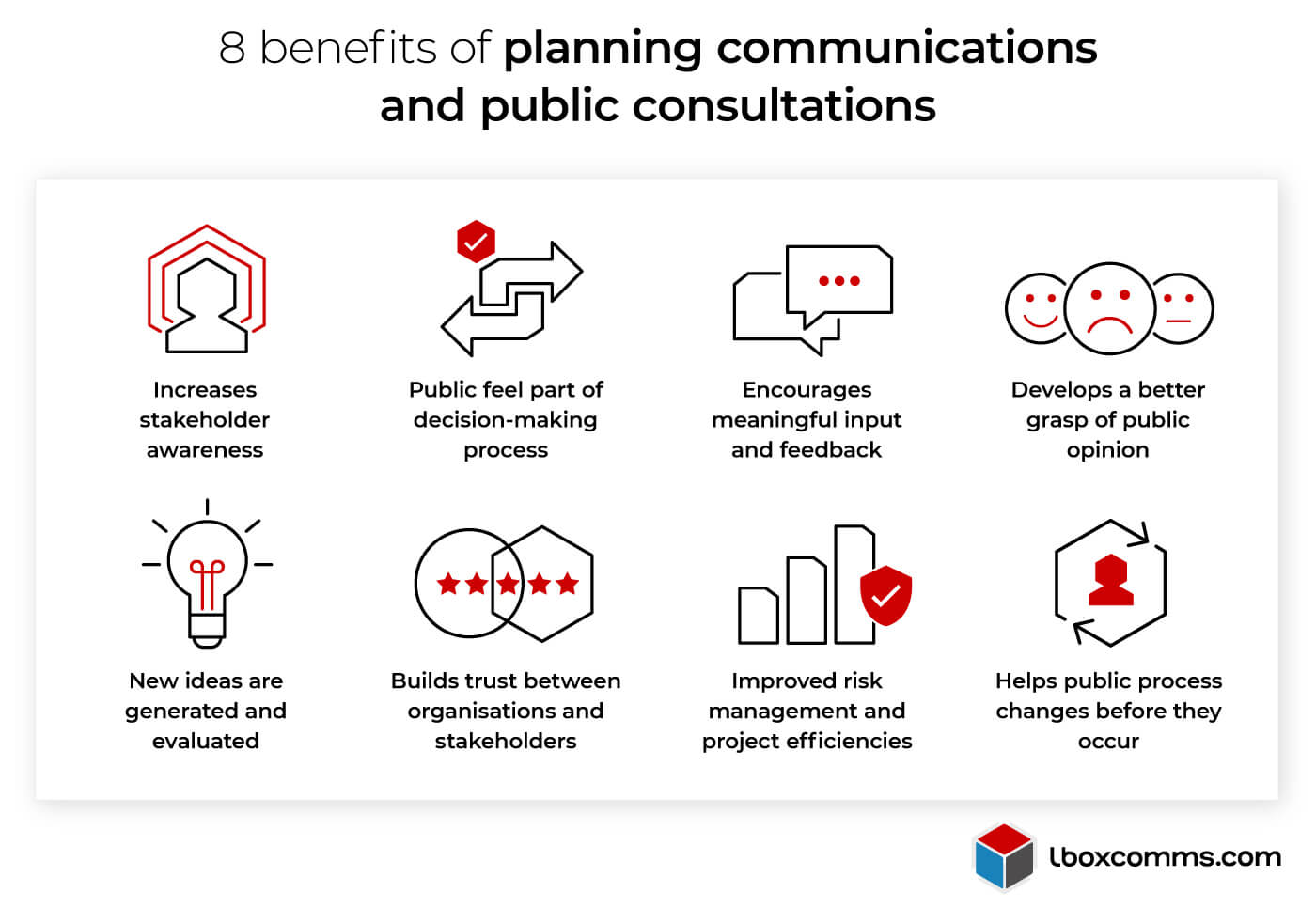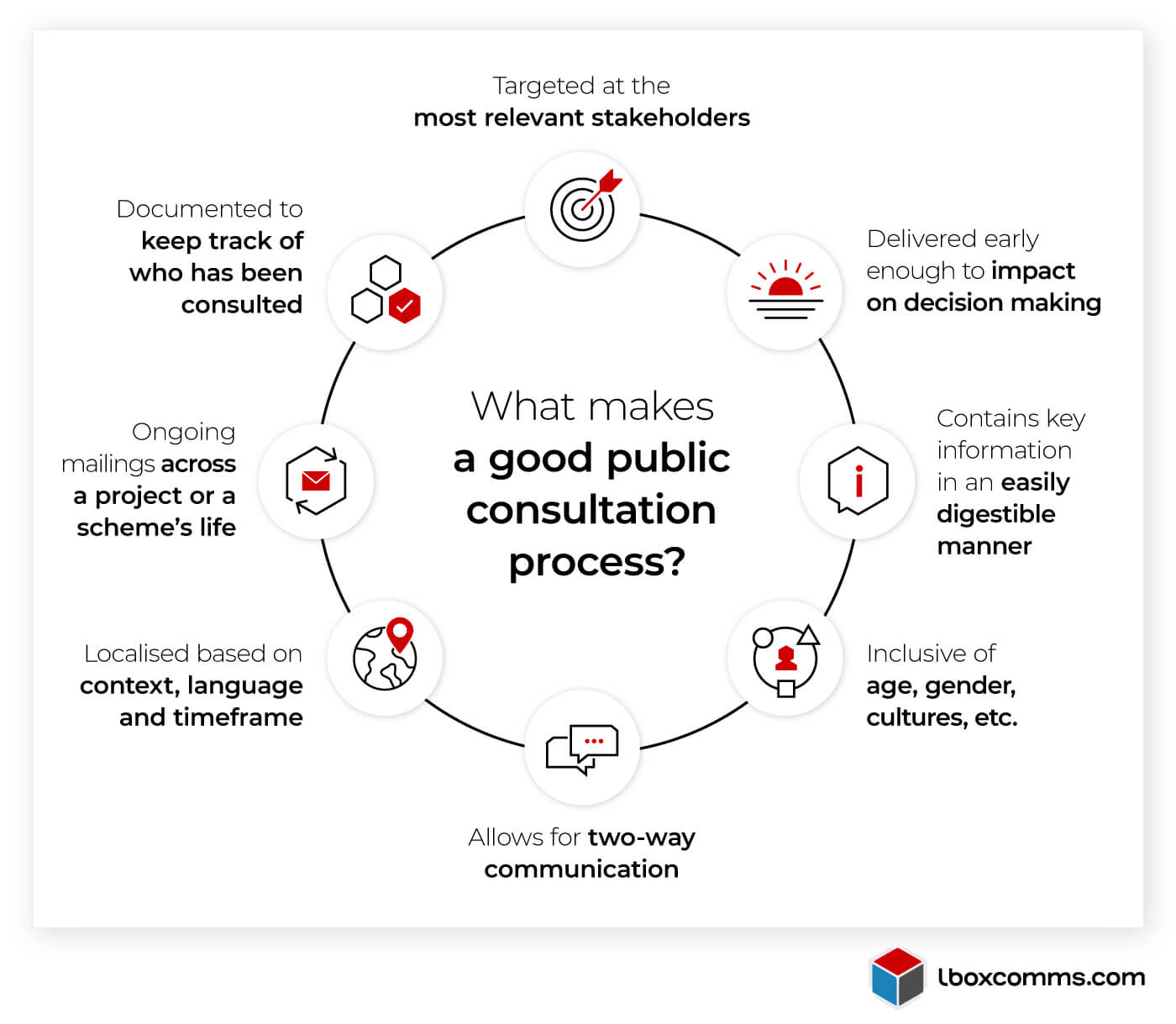
Ahead of any project, proposal or development, it is imperative that stakeholders are kept in the loop about what is happening, why it’s happening, and how they’ll be affected. Whether a legal requirement or simply following best practice, planning communications and public consultations are crucial in ensuring relevant groups are engaged and informed.
Here, we dive into this extensive area to give you all of the information, advice and guidance you need to make your resident communications as relevant and effective as possible.
What are planning communications and public consultations?
In a nutshell, planning communications and public consultations are materials that inform the public on an upcoming development or proposal, and invite their views and feedback ahead of implementation.
This could be alerting the local community of a planning application for a building project that could temporarily disrupt their daily life. Or making people aware of a proposal from the local government or council before it is implemented. It is all about raising awareness in an effort to minimise future disruption or discontent.
Who is the public? More appropriately referred to as stakeholders, these are the individuals, organisations and interest groups that may be directly or indirectly affected by the topic of your communications. Your audience may also include people who can directly influence outcomes, or simply have an interest in what is being planned/proposed.
In order to identify who your “public” is ahead of any planning communications, consider the following:
Who is affected by this subject of your communications?
Who may have an influence on this matter?
Who knows about the subject?
Who has a particular interest in the subject?
While in past decades these communications have been short-term campaigns to fulfil statutory requirements, in recent years there has been a greater emphasis on maintaining a continuous dialogue between decision-makers and the public. This helps keep everyone on the same page throughout a project or proposal’s lifecycle, reducing the risk of unwelcome surprises.
Examples of planning communications and public consultations
Some examples of public consultation and planning communications include (but are not limited to):
Planning applications
Community engagement newsletters
Environmental Impact Assessments (EIA)
Letters to stakeholders
Feedback forms and questionnaires
Works notifications
Noise disruption notifications
Legislative proposals
Spending programmes
Town and country planning notices
Statement of Community Involvement documents
All of these communications serve the purpose of notifying residents, businesses, constituents and stakeholders of must-know information.
What is the importance of public consultations and planning communications?
While it costs money to produce good communications for stakeholders, the cost of not doing so can be even greater.
Often, planning communications and public consultations are legal obligations and are generally required as part of the planning phase of any project or proposal. However, what this means in practice will depend on the specific requirements of your organisation and industry.
For example, in the UK there is only voluntary guidance for public bodies in how they engage stakeholders when developing new policies or legislation. But there are some legal duties for certain bodies, such as:
Clinical commissioning groups must send planning communications to stakeholders under the NHS Act 2006 Section 14Z2
The need for pre-application consultation on nationally significant infrastructure projects under the Planning Act 2008
In private sectors, the specific requirements for public consultations and communications are set by individual regulators and borrowers. These will typically depend on the social, economic and environmental risks that a development presents to affected stakeholders.
For those legally obliged to do so, failing to take the necessary steps to communicate with relevant audiences can carry financial penalties, as well as lead to ongoing complaints from those left unaware about how a project or proposal would affect them.
But, as noted earlier, the value and importance of these residential communications are not limited to fulfilling a legal quota. More and more frequently organisations are playing a key role in building relationships with stakeholders and providing long-term updates, with the primary aim of achieving better outcomes.
The more informed and involved people are in a development that affects them, the simpler it is for work to be completed on schedule with minimal disruption. It can also foster stronger bonds between a group and its audiences, boosting its reputation in the eyes of local communities.

7 best practice tips for your planning communications and public consultations
For developers, communities and decision-makers, one of the biggest challenges in taking forward a development scheme is to ensure that public engagement is undertaken in a way which is meaningful, inclusive and brings benefits to all involved.
Crafting materials that not only meet your legal obligations, but also actively do their job in engaging and notifying recipients, is not a straightforward feat. Below, we outline our 7 recommendations for good communications (with reference to GOV.UK’s public consultation requirements).
1. Pinpoint the purpose of your communications
Are you looking to draw attention to upcoming works through community newsletters? Encourage views from residents in feedback forms? Build understanding and arouse interest in a project or scheme?
Nailing down the purpose and goals of your planning communications and public consultations will be the foundation of what your materials look and feel like, such as:
The design, copy and visuals of your communications
Whether you send a one-pager or a more comprehensive brochure
The level of consultation and information you feel compelled to give readers
2. Ensure your campaign targets the right people
Precise targeting of your stakeholders is crucial to both ensuring that your campaign is 100% relevant and that the costs behind your deliveries are optimised. You only want to reach people who could be affected by or have a legitimate interest in your project or scheme, with no excess waste.
Once you have solid data and targeting in place to guide your campaign, you can take further steps to personalise your communications, making it more likely that readers will engage.
Having access to a free planning communications mapping tool like tellthem™ makes locating and mapping your audiences exact and seamless. Immediate search hones in on precise areas, while our three intuitive mapping tools draw your delivery zones in seconds.
3. Keep language and layouts clear and concise
Use plain language and stay away from acronyms and jargon wherever possible. You want to make all information you give to recipients as easy to digest as you can, so that they aren’t left with more questions than they had prior to receiving your communications.
4. Provide relevant information
While not going overboard on text in order to maintain people’s attention, ensure readers receive enough information that they can make informed, educated responses when feeding back on your proposal. Ill-informed feedback can lead to unnecessary delays in a project’s progress.
If you are intending to send a significant amount of information, consider mixing this between images and design elements to better keep people engaged.
5. Determine the length of the consultation period
Does your proposal demand a one-off notification, a feedback form, or a consistent flow of information over the course of several months or years? Establishing this early by creating a communications plan will help you better organise when your mailings should reach audiences in accordance with your responsibilities.
While additional unforeseen communications may be required due to delays or changes to a project or proposal, having a baseline strategy and timeline can make the planning process significantly more streamlined and cost-efficient.
6. Tailor your communications to your audiences
With strong targeting in place, you can take your planning communications to the next level by tailoring their content around your exact audience. This could include:
Personalising envelopes, letterheads and more with recipients’ names
Writing in different languages and depicting culturally appropriate imagery for specific local communities
Providing bespoke information that certain interest groups would prioritise
Updating calls-to-action based on a person’s location or demographics
7. Make your calls-to-action clear for readers
Particularly on public consultation forms and questionnaires, you absolutely want to make sure you clearly signpost how stakeholders can get in touch with you if they have thoughts or comments.
Whether this is a phone number, email address, website link, or address to send their completed questionnaire or survey to, this information should be bold and distinct for all readers.
What is the right process for your planning communications?
There is no one “right way” of undertaking planning communications or public consultations. The planning process behind it will undoubtedly shift based on the nature, purpose and frequency of a campaign.
However, in most cases a good consultation process will have several key features:

In addition, for the best return on your communications and complete coverage across your target audience, it is essential to have a partner that you can depend on. One that makes the often stressful and time-consuming work behind these crucial notifications completely disappear.
tellthem™ – the smarter way to plan and send public consultations
With tellthem™, our free-to-use, one-of-a-kind Targeted Delivery & Mapping Platform (TDMP), getting vital information out to residents, businesses, constituents and stakeholders has never been faster, smarter or simpler.
We understand how important it is that you keep people in the loop of any projects, proposals and disruptions well ahead of these being implemented. We give you the tools to quickly, effectively and easily organise your project communications, and deliver practical, informed advice on the most beneficial, cost-effective and time-saving methods of delivery.
Arrange every aspect of your campaigns in one intuitive online platform
Plan an infinite number of campaigns at no cost – you only pay for print, fulfilment and delivery services
Locate your audience immediately with our versatile search system, and highlight delivery areas in seconds with 3 easy-to-use mapping tools
Choose from 1st and 2nd class Royal Mail delivery across the UK, or unaddressed delivery to anywhere inside this area
Fast turnaround, high-quality print and fulfilment for any size and scale of mailings
If you’re ready to discover the faster, simpler way to get your communications and consultations in peoples’ hands, reach out to our team and let’s get started.



